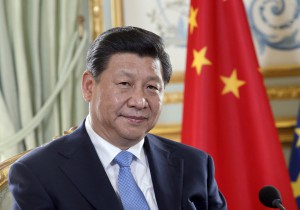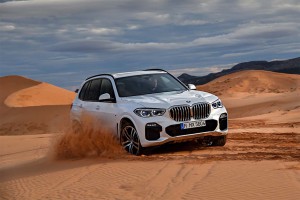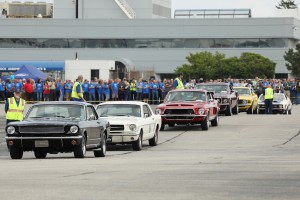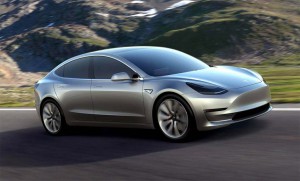The auto industry has found itself at Ground Zero as the U.S. and China escalate their trade war.
After the latest move by the Trump Administration to target Chinese imports, the Beijing government has announced it will strike back with 25% tariffs on $16 billion in imported U.S. goods. China previously enacted new duties on $34 billion worth of goods, bringing the total to $50 billion. And with the White House threatening to add another $200 billion to the U.S. list, the trade war could escalate rapidly.
The latest round sees the Chinese Ministry of Commerce placing an additional 25% duty on a list of American products that includes coal, crude oil and metal scrap, as well as automobiles and motorcycles. A number of automakers could be hit hard by the new sanctions, including Ford Motor Co., Mercedes-Benz and BMW.
(U.S. trade partners jointly explore options ahead of possible tariff war. Click Here for more.)
China is the world’s largest automotive market, sales rising to about 24 million vehicles in 2017 compared to 17.2 million in the United States. Imports, however, are barely in the single digit share of the Chinese market, with about 300,000 American-made vehicles generating just $10.5 billion in sales, according to U.S. trade data.
Ford and BMW are two of the largest U.S.-based exporters to China, the German marque, the latter maker exporting sport-utility vehicles from a plant in Spartanburg, South Carolina to China. BMW has been warning that it could be forced to trim back investment plans for that factory if the escalating trade war cuts into demand.
Complicating matters, the Trump Administration is also threatening to go to war with Europe over automotive exports – Pres. Donald Trump himself telling French President Emmanuel Macron earlier this year that he was prepared to effectively drive Mercedes-Benz out of the American market. That dispute has been put on hold, for the moment, with European Union and American representatives discussing a variety of options that could see both sides eliminate automotive tariffs all together.
Ironically, China’s President Ji Xinping had promised to cut tariffs on foreign-made autos in comments made in April of this year. Prior to this latest round of retaliatory actions, automotive imports were subject to duties of 25 percent, or 10 times more than the 2.5% tariff imposed by the U.S.
On a $35,000 Ford Mustang, for example, duties had added $8,750 to the base price, making it far less competitive with vehicles produced in China. Ford earlier this summer suggested it may try to absorb any punitive duties imposed by the Chinese in a bid to prop up what have already been flagging sales in the huge Asian market.
(Ford marks sale of 10 millionth Mustang. Click Here for the story.)
Other manufacturers, including BMW, have indicated they will pass on at least some of the additional costs. But that is expected to make American-made vehicles even less competitive in the Chinese market, something expected to result in declining demand. In turn, industry analysts warn that at least some U.S. plants could be forced to trim production and possibly even cut jobs.
Other manufacturers who could be hurt by China’s latest move include Fiat Chrysler Automobiles, General Motors, Toyota and Tesla. The California-based battery-carmaker has struggled to gain traction in China and recently announced plans to set up a new plant there, but it won’t open for several more years.
As for General Motors, it could be hit doubly hard by the trade war. The Chevrolet Camaro is one of the 20 most popular American-made cars sold in China. But GM is also importing one of its more popular SUV models, the Buick Envision, from China. It has approached the White House seeking a exemption from any new duties imposed on Chinese-made vehicles.
(Click Here or more about Ford’s ongoing sales issues in China.)

Ironically, Chinese President Xi Jinping wanted to lower Chinese auto tariffs before the trade war began.
For the moment, China actually ships relatively few vehicles to the U.S., these include not only the Buick Envision but also several versions of the Volvo S60 sedan. That Swedish-based company is owned by China’s Zhejiang Geely and plans to add more Chinese-made products to the list over the next several years. Ford is also planning to join the list of importers over the next several years.
A number of China’s domestic brands also have been laying out plans to enter the American market. Though such moves have repeatedly been delayed, Szchuan’s GAC is currently putting together a U.S. distribution network and, barring further escalation of the trade war, could begin retail sales in 2019. Others set to follow include BYD and Great Wall.
All told, Americans bought about 50,000 Chinese-made vehicles in 2017, but a forecast by the Center for Automotive Research anticipates that will reach 225,000 by 2019 and 500,000 by 2023 – barring new trade restraints, of course.
Here’s a list of the 20 most popular American vehicles imported by China, based on 2017 sales, according to data firm LMC Automotive;
- BMW X5: 52,407
- Mercedes-Benz GLE: 40,304
- BMW X3: 34,609
- Lincoln MKC: 17,753
- Mercedes-Benz GLS: 17,420
- Mercedes-Benz R-Class: 13,402
- Ford Explorer: 12,906
- BMW X4: 10,928
- BMW X6: 9,027
- Tesla Model X: 8,848
- Jeep Grand Cherokee: 8,832
- Toyota Sienna: 7,460
- Ford Mustang: 7,137
- Tesla Model S: 5,931
- Jeep Wrangler: 5,302
- Lincoln Continental: 4,927
- Lincoln Navigator: 1,764
- Jeep Cherokee: 1,697
- Mercedes-Benz GL-Class: 1,061
- Chevrolet Camaro: 977



